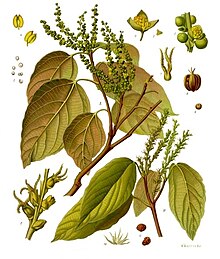| Mallotus | |
|---|---|

| |
| Kamala tree (M. philippensis)[1] | |
| Scientific classification | |
| Kingdom: | Plantae |
| Clade: | Tracheophytes |
| Clade: | Angiosperms |
| Clade: | Eudicots |
| Clade: | Rosids |
| Order: | Malpighiales |
| Family: | Euphorbiaceae |
| Subfamily: | Acalyphoideae |
| Tribe: | Acalypheae |
| Subtribe: | Rottlerinae |
| Genus: | Mallotus Lour. |
| Synonyms[2] | |
| |




Mallotus is a genus of the spurge family Euphorbiaceae first described as a genus in 1790.[4] Two species (M. oppositifolius and M. subulatus) are found in tropical Africa and Madagascar, while all others are found in East Asia, the Indian Subcontinent, Southeast Asia, eastern Australia, and certain islands of the western Pacific.[2][5][6][7] The genus has about 150 species of dioecious trees or shrubs.[8]
- ^ 1897 illustration from Franz Eugen Köhler, Köhler's Medizinal-Pflanzen
- ^ a b Kew World Checklist of Selected Plant Families
- ^ Burkhardt, Lotte (2018-06-06). Verzeichnis eponymischer Pflanzennamen – Erweiterte Edition. Index of Eponymic Plant Names – Extended Edition. Index de Noms éponymiques des Plantes – Édition augmentée (in German). Botanic Garden and Botanical Museum Berlin, Freie Universität Berlin. p. A7. doi:10.3372/epolist2018. ISBN 978-3-946292-26-5. S2CID 187926901.
- ^ Loureiro, João de. 1790. Flora Cochinchinensis 601, 635
- ^ Flora of China Vol. 11 Page 225 野桐属 ye tong shu Mallotus Loureiro, Fl. Cochinch. 2: 635. 1790.
- ^ Govaerts, R., Frodin, D.G. & Radcliffe-Smith, A. (2000). World Checklist and Bibliography of Euphorbiaceae (and Pandaceae) 1–4: 1–1622. The Board of Trustees of the Royal Botanic Gardens, Kew.
- ^ Sierra, S.E.C. & Van Welzen, P.C. (2005). A taxonomic revision of Mallotus section Mallotus (Euphorbiaceae) in Malesia. Blumea 50: 249–274.
- ^ Yamasaki, Eri; Sakai, Shoko (2013). "Wind and insect pollination (Ambophily) of Mallotus spp. (Euphorbiaceae) in tropical and temperate forests". Australian Journal of Botany. 61: 60. doi:10.1071/BT12202. hdl:2433/173327.
Cite error: There are <ref group=lower-alpha> tags or {{efn}} templates on this page, but the references will not show without a {{reflist|group=lower-alpha}} template or {{notelist}} template (see the help page).